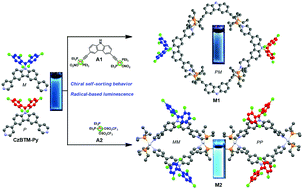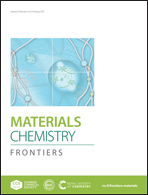Facile construction of well-defined radical metallacycles through coordination-driven self-assembly†
Abstract
Recently, the marriage of organic radicals and supramolecular chemistry has given birth to a booming research field of supramolecular radical chemistry. However, the well-developed supramolecular radical systems are still limited, especially at present the supramolecular coordination radical systems are rarely explored. The construction of discrete supramolecular radical coordination complexes such as radical metallacycles and metallacages still remains a great challenge mainly because of the intrinsically unstable nature of organic radicals and the lack of suitable coordination method. Herein, we design and synthesize a new organic radical ligand CzBTM-Py with well-defined coordination geometry and persistent stability. Subsequently, two discrete radical metallacycles of M1 and M2 are successfully and efficiently constructed via the coordination-driven self-assembly approach. Due to the mild coordination reaction conditions the open-shell nature of CzBTM-Py is preserved as indicated by the electron paramagnetic resonance (EPR) spectroscopy. The chemical structures of CzBTM-Py, M1 and M2 are successfully determined by X-ray crystallography. Interestingly, a chiral self-sorting behavior is observed in this coordination-driven self-assembly process, i.e., M1 exists as MM/PP enantiomers couple while M2 exists as the heterochiral PM form. Moreover, the photophysical properties of the radicals have changed significantly after coordination, making the color and emission of M1 and M2 differ from those of CzBTM-Py. Additionally, metallacycles M1 and M2 show better photostability than radical ligand CzBTM-Py. This work successfully demonstrates a highly efficient coordination-driven self-assembly approach to synthesize radical-based supramolecular coordination complexes, which could modulate the chemical and physical properties of organic radicals, and thus to develop new functional metal–organic radical materials.

- This article is part of the themed collections: FOCUS: Macrocyclic and supramolecular chemistry and The 1st Sauvage Symposium


 Please wait while we load your content...
Please wait while we load your content...